The meeting with a
cycle Stories in clouds gives the opportunity to visit the most bizarre places.
That the sky space, which in its
heterogeneity forces you to take a fantastic and abounding journey with many astonishing
surprises. The adulthood looses in that world with the need of looking at things with
the eyes of a child.
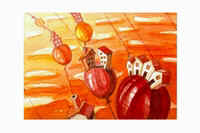 Gosia Seweryn's sky is not "the other world", which
exists in the context of the ultimate things, but extremely dynamic world of happy
daydreaming among visions of things similar to child toys. But it is not a child who plays
with those toys, the Artist does, and - if you accept the game rules proposed by her - the
observer of her world, who is rather an adult person. In that situation the elements of
children's game start to take meaning of the careless and momentary escape into the world
of dreams from the childhood, and also a little bitter longing for it. Colours and tones
chosen by the Author are obviously the term of light-heartedness, they remind the sun, and
they are cheerful. However, after a while you cannot mistake those colours with the
colours of desert.
Gosia Seweryn's sky is not "the other world", which
exists in the context of the ultimate things, but extremely dynamic world of happy
daydreaming among visions of things similar to child toys. But it is not a child who plays
with those toys, the Artist does, and - if you accept the game rules proposed by her - the
observer of her world, who is rather an adult person. In that situation the elements of
children's game start to take meaning of the careless and momentary escape into the world
of dreams from the childhood, and also a little bitter longing for it. Colours and tones
chosen by the Author are obviously the term of light-heartedness, they remind the sun, and
they are cheerful. However, after a while you cannot mistake those colours with the
colours of desert.
The cycle diffuses the large amount
of motives, which on the one hand live their own life, and on the other, possess singular
connotations, but probably, the more important are the net connections between them.
Together, they create a group of signs, which intermingle each other, open imagination,
arouse emotions despite the seemingly atmosphere of peace.
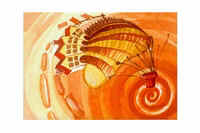 That universe possesses its own, precise composition and logic.
But for that several torn connections, the tension between objects, the balloons carrying
houses and castles flying away into unknown space - you could suspect the Author of
creating an ideal vision of the imagination world with the features from the Arcadia,
filled with safety, which gives the metal arms that are strongly clipping the spheres,
lines (the theme of connections refers to Roberto Matty's painting related to New York
School, and the wired constructions of crosses on the planets in "Gardener" by
Wladyslaw Hasior). There are lots of houses with cheerful, warm shapes, walls, castles,
and well-constructed towers. Many of them have crowns on the peaks: someone in this world
is watching over our safety, taking care of its stability. The meaningful royal regalia
are also visible here - there is a distinction between the king and the queen: crowns,
which represent them, indicate gender. It is also the condition of harmony and order
persistence of two closely related environments: male and female. Any trace of feminism or
the patriarchy suspicions does not break the harmony.
That universe possesses its own, precise composition and logic.
But for that several torn connections, the tension between objects, the balloons carrying
houses and castles flying away into unknown space - you could suspect the Author of
creating an ideal vision of the imagination world with the features from the Arcadia,
filled with safety, which gives the metal arms that are strongly clipping the spheres,
lines (the theme of connections refers to Roberto Matty's painting related to New York
School, and the wired constructions of crosses on the planets in "Gardener" by
Wladyslaw Hasior). There are lots of houses with cheerful, warm shapes, walls, castles,
and well-constructed towers. Many of them have crowns on the peaks: someone in this world
is watching over our safety, taking care of its stability. The meaningful royal regalia
are also visible here - there is a distinction between the king and the queen: crowns,
which represent them, indicate gender. It is also the condition of harmony and order
persistence of two closely related environments: male and female. Any trace of feminism or
the patriarchy suspicions does not break the harmony.
The ensigns, the scarves similar to
simultaneous compositions of sacral art of the Middle Ages are also the royal symbols. The
ensigns on the towers' peaks testify to the stability and immutability of intense
authority.
The universe has its own internal
communication. Sometimes the figures communicate with each other almost literally - we can
observe for example two planets with buildings on them, with aerials, which are bending
towards each other in nearly intimate dialogue.
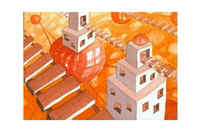 The motives are joined with bridges, rail tracks are flowing
through the building windows, and under the castles' arcades the gigantic ribbons are
spreading with no beginning and without end. Their placement and function remind of the
tree branches, which behave as on F. Ackermann's paintings.
The motives are joined with bridges, rail tracks are flowing
through the building windows, and under the castles' arcades the gigantic ribbons are
spreading with no beginning and without end. Their placement and function remind of the
tree branches, which behave as on F. Ackermann's paintings.
They are taking part in organizing
the omnipresent geometrical order: consists of scarves system, which intersects - creating
almost regular tetragonal net. Ellipses, spheres, spirals and circles are all over the
place among merging straight lines and sections.
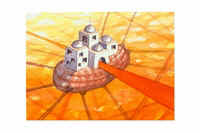 But when we observe those connections, it appears that the lines
and metal rods are tense, they are heavily loaded with keeping the world as a
whole. Some of them have not given up that huge pressure of world's mass so far, but
on many graphics you can see the above-mentioned broken strings of balloons flowing away
into a deep space. Castle and bridge's strong walls are settled on a number of balloons
with loosely hanging strings.
But when we observe those connections, it appears that the lines
and metal rods are tense, they are heavily loaded with keeping the world as a
whole. Some of them have not given up that huge pressure of world's mass so far, but
on many graphics you can see the above-mentioned broken strings of balloons flowing away
into a deep space. Castle and bridge's strong walls are settled on a number of balloons
with loosely hanging strings.
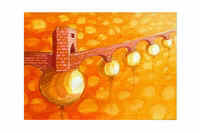 In the amazing system of various figures we can suddenly perceive
this paradox: how is it possible that this firm edifice can exist on the airy row of
balloons? Maybe in contrast to monumental building the lightness appears here in all of
her mighty power? Or maybe it is the main rule for the existence of the material world
built with strong arms of the material world? Without support of the woman's finesse, a
man loses the power of creating or the motivation of building his palaces or fortresses.
The same paradox can substantiate the logic of "placing" the buildings of
dimensions incomparable with planets, which they were placed on.
In the amazing system of various figures we can suddenly perceive
this paradox: how is it possible that this firm edifice can exist on the airy row of
balloons? Maybe in contrast to monumental building the lightness appears here in all of
her mighty power? Or maybe it is the main rule for the existence of the material world
built with strong arms of the material world? Without support of the woman's finesse, a
man loses the power of creating or the motivation of building his palaces or fortresses.
The same paradox can substantiate the logic of "placing" the buildings of
dimensions incomparable with planets, which they were placed on.
The Background for this space
theatre is filled with spirals and circles, making an impression of incessant movement,
dynamic pulsation setting the air in flutter. The ensigns are fluttering, the balloons are
flying away dragging the broken lines - as if the sudden gusts of wind would like to burst
the subtly woven composition. Spirals' rings are carrying away the crowns, separating them
with dramatic speed and moving them into the unknown abyss.
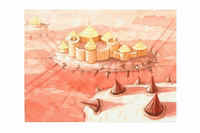 Also the colours seemingly build the cheerful picture of this
galactic. The colour of sand, golden crowns, orange ground (or the sky - sometimes it is
hard to tell). But there is the dynamics in that colour system, which does not allow for
stopping the sight at the bottom and telling exactly, that the ground is right here and
the sky is above. They are often clearly separated, the colours intermingle only in some
places. On the most of paintings, the sky and the ground are replaced by circles and
spiral colours, a play of yellow and orange transforming into red and a little gloomy
brown.
Also the colours seemingly build the cheerful picture of this
galactic. The colour of sand, golden crowns, orange ground (or the sky - sometimes it is
hard to tell). But there is the dynamics in that colour system, which does not allow for
stopping the sight at the bottom and telling exactly, that the ground is right here and
the sky is above. They are often clearly separated, the colours intermingle only in some
places. On the most of paintings, the sky and the ground are replaced by circles and
spiral colours, a play of yellow and orange transforming into red and a little gloomy
brown.
From the image of a couple of
planets with stumps of cut trees the sadness of lost and lapse appears, the dry scenery is
devoid of plants and sets us in dejection. There are no people or nature elements there.
The objects function for themselves. Maybe they are waiting for an observer, whom that
whole universe - playground is prepared for.
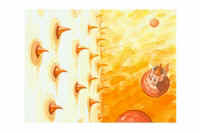 Maybe it is a place for a tired wanderer, tired of worries and
problems, which surpass him too often. Let those stories happen in clouds, in the world of
imagination, where no one cries over a balloon flying away. Nothing is for real here.
Maybe it is a place for a tired wanderer, tired of worries and
problems, which surpass him too often. Let those stories happen in clouds, in the world of
imagination, where no one cries over a balloon flying away. Nothing is for real here.
Mariola Konieczna